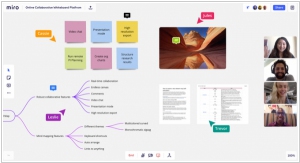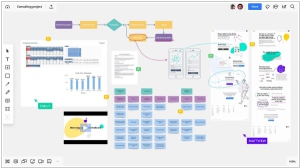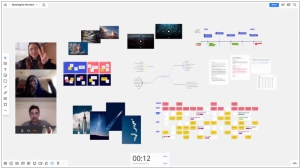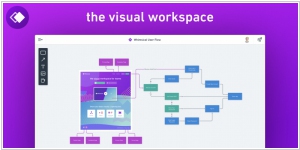Miro vs Whimsical
June 13, 2023 | Author: Adam Levine
See also:
Top 10 Visual Collaboration software
Top 10 Visual Collaboration software
Miro and Whimsical are both collaborative online whiteboard platforms, but they have distinct differences in their features and focus. Miro is a versatile tool that offers a wide range of features for visual collaboration, including virtual whiteboards, sticky notes, mind maps, diagrams, and real-time collaboration. It caters to various use cases, such as brainstorming, project management, agile workflows, and design thinking. Miro provides a robust platform for teams to ideate, collaborate, and organize their work visually.
Whimsical, on the other hand, focuses on simplicity and ease of use. It offers intuitive tools for creating flowcharts, wireframes, sticky notes, and mind maps. Whimsical's clean and minimalist interface allows users to quickly sketch ideas and visualize concepts without overwhelming complexity. It is well-suited for individuals and teams seeking a straightforward and user-friendly platform for visual collaboration and brainstorming sessions.
See also: Top 10 Visual Collaboration software
Whimsical, on the other hand, focuses on simplicity and ease of use. It offers intuitive tools for creating flowcharts, wireframes, sticky notes, and mind maps. Whimsical's clean and minimalist interface allows users to quickly sketch ideas and visualize concepts without overwhelming complexity. It is well-suited for individuals and teams seeking a straightforward and user-friendly platform for visual collaboration and brainstorming sessions.
See also: Top 10 Visual Collaboration software
Miro vs Whimsical in our news:
2020. Miro lands $50M Series B for digital whiteboard as demand surges

Miro, the creator of a digital whiteboard, is experiencing a significant surge in usage as businesses transition from physical workspaces to remote environments. In light of this, the company has recently announced an impressive $50 million Series B funding round. Miro sets itself apart by being more than just a lightweight add-in typically found in collaboration tools like Zoom or Microsoft Teams. It functions as a platform that integrates with various enterprise tools, much like Slack does for communication. This integration capability allows users to customize the base tool and build integrations with other commonly used tools, tailoring it to the specific needs of their teams or organizations. This approach has proven successful, with Miro reporting profitability and boasting more than 21,000 customers, including 80% of the Fortune 100 companies. Notable customers of Miro include Netflix, Salesforce, PwC, Spotify, Expedia, and Deloitte.
2018. RealtimeBoard, a visual collaboration platform for companies, raises $25M

RealtimeBoard, an effective visual collaboration tool designed for distributed teams, has secured $25 million in Series A funding. The company intends to utilize the additional investment to support its ongoing expansion efforts. This includes enhancing customer acquisition capabilities through the strengthening of sales and marketing teams, as well as fostering growth within its user community. RealtimeBoard aims to develop a comprehensive visual collaboration platform that facilitates digital whiteboarding and serves as a central hub for integrating various collaboration tools utilized by organizations. Notable companies such as Hubspot, Skyscanner, Qlik, Autodesk, Netflix, and Twitter are among RealtimeBoard's esteemed customers, with the platform boasting a user base of 2 million worldwide. The startup generates revenue by offering its software-as-a-service (SaaS) on a per-seat basis for teams or entire companies.





